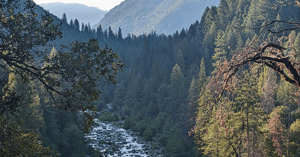Beauty and Technology: The Yuba River and the Webb Telescope’s First Images
Technology can both reveal beauty and foster a sense of awe.
Natural Beauty and Technology: Gold Mining on the Yuba
The Yuba River in California rushes through a jumble of boulders and cliffs and wanders lazily in deep pools. Located in Northern California, It is a popular vacation spot and is an oasis of river, trees, and rugged landscapes. Some of the dramatic rock pilings along the river, however, are "tailings” from gold mining, left behind by the California Gold Rush of 1849. Tailings are piles of debris created by hydraulic mining, a technique originally developed by the Romans. During the Gold Rush, this technique involved water cannons firing 185,000 cubic feet of water at a velocity of 150 ft/sec. This is quite a feat and a testament to human ingenuity.
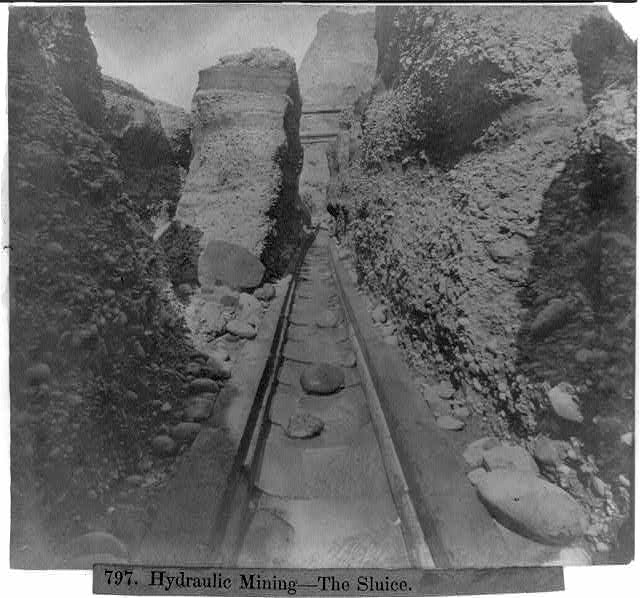
Image Credit: Lawrence & Houseworth, Publisher. Hydraulic Mining—The Sluice. [Published] Photograph.
Retrieved from the Library of Congress
This is early technology at work, making its mark on the landscape. In spite of it, the raw beauty of the area remains intact. The oaks and cedar trees are like majestic sculptures. The rock formations and the variety of rocks with their startling striations and the sheer diversity in size and shape are a path to experiencing the grandeur of Creation. Every morning, as I sit on the porch of a cabin above this river, I have experienced the beauty and peace of the place in a feeling I can only describe as reverential awe.
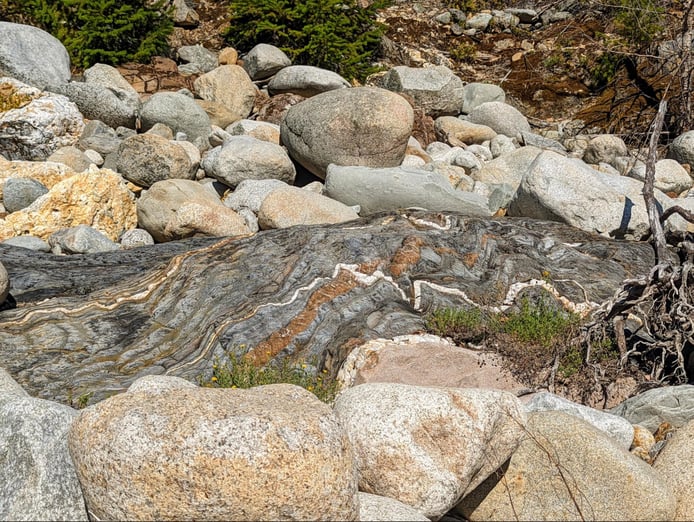
Image Credit: Tim O'Reilly
Sitting on that same porch, in the quiet morning hours, I viewed the first images from the James Webb Space Telescope. This space observatory, operating 1 million miles from earth, contains the most advanced technology ever created and has been described as humanity’s greatest engineering achievement. Once again, I am in awe.
Cosmic Beauty and Technology: James Webb Telescope First Images
The James Webb Space Telescope (JWST) launched on Christmas Day, 2021, delivered its first images which were unveiled July 11, 2022. Bill Nelson, NASA administrator, commented:
Today, we present humanity with a groundbreaking new view of the cosmos from the James Webb Space Telescope – a view the world has never seen before.
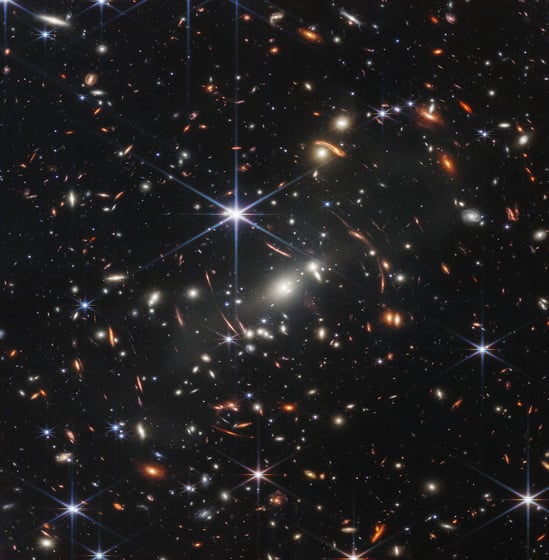
Webb's First Deep Field (NIRCam Image)
Image credit: NASA, ESA, CSA, and STScI
Because of the expansion of the universe, the light from the images is “stretched out” into infrared wavelengths and is captured by JWST’s 21 foot mirror and the infrared instruments on board. This means the light captured in the deep field image is from the first billion years of the universe’s formation. This is astonishing given that the universe is believed to be about 13.8 billion years old. What makes it even more astonishing–besides being incredibly beautiful and awe inspiring–is the level of organization even in the universe’s early history. There are multiple galaxies in various stages of development, star forming regions, and even structures that astronomers have never seen before.
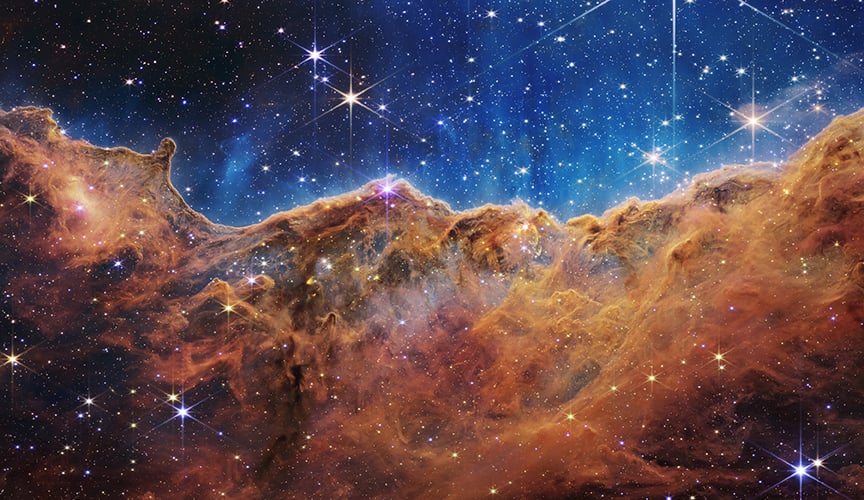 “Cosmic Cliffs” in the Carina Nebula (NIRCam Image)
“Cosmic Cliffs” in the Carina Nebula (NIRCam Image)
Image credit: NASA, ESA, CSA, and STScI
Other images were selected for the unveiling of the JWST’s capabilities, including the dramatic and majestic image of the nearby star forming region in the Carina Nebula. The NASA website poetically described this almost 3D looking image as “craggy mountains on a moonlit evening.” The description continues:
In reality, it is the edge of the giant, gaseous cavity within NGC 3324, and the tallest “peaks” in this image are about 7 light-years high. The cavernous area has been carved from the nebula by the intense ultraviolet radiation and stellar winds from extremely massive, hot, young stars located in the center of the bubble, above the area shown in this image.
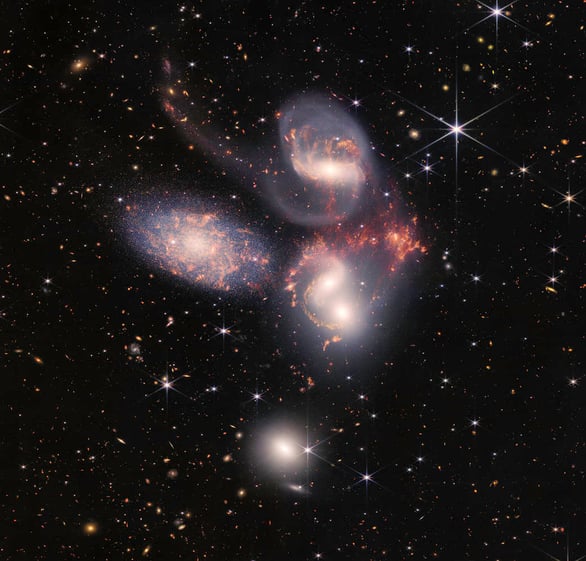
Stephan's Quintet (NIRCam and MIRI Composite Image)
Image credit: NASA, ESA, CSA, and STScI
The image of Stephan’s Quintet reveals a dying star and colliding galaxies. Closer to home, spectral data of a nearby exoplanet, approximately 1100 light years away, has captured the signature of water and indications of haze and clouds in the atmosphere.
Whether the JWST first images are from the light of dying stars or newborn stars, from the light of the early universe or from colliding galaxies, in the words of NASA’s Bill Nelson:
Every image is a new discovery and each will give humanity a new understanding of our place in this remarkable universe.
So from gold mining on the Yuba to capturing images of the cosmos, it is worth contemplating the gift of human ingenuity. Whether contemplating the natural beauty of our own planet or the cosmic beauty in the farthest regions of the universe, we can rejoice that the richness of creation is ours to behold, and it can remind us of God’s goodness and glory.
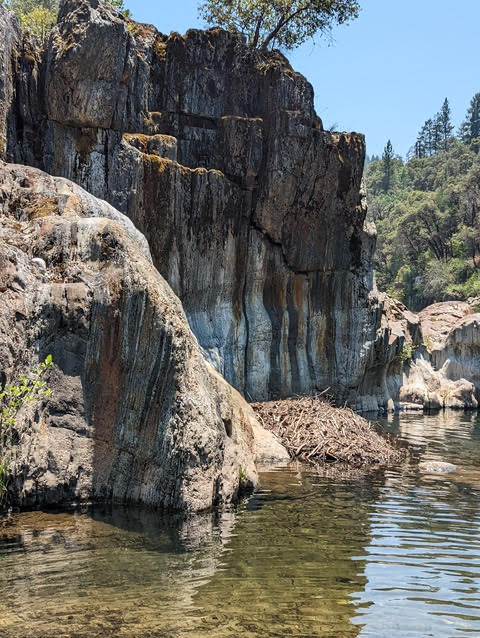 Image Credit: Tim O'Reilly
Image Credit: Tim O'Reilly
Feature Image Credit: Tim O'Reilly
